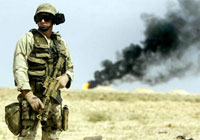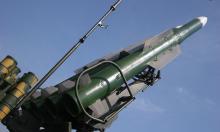Human Terrain System in the Kill-Pacify Chain
Key Element in Obama’s Hearts & Minds, Smart Power Campaign

By John Stanton
On 5 August 2009 the US Government’s General Services Administration and HQ Training & Doctrine Command (TRADOC) sponsored a Bidder’s Conference for defense contractors looking to work in the US Army and Marine Corps Irregular Warfare program. The subject of that conference was new opportunities for recruiting, training, and managing the US Army’s Human Terrain System (HTS). HTS is set to become a pivotal element, according to documentation, in other US combatant commands besides CENTCOM; namely, SOCOM, AFRICOM, STRATCOM, and PACOM. Can NORTHCOM and EUCOM be far behind? HTS is currently funded by US Army TRADOC’s Deputy Chief of Staff for Intelligence (G2) and CENTCOM. Long term requirements have been validated for funding in the Common Operating Picture funding line of the US Army budget in Presidential Review Briefing 11-15.
Citing specifications, the US Army Training & Doctrine Command (TRADOC) has broadened its efforts to include supporting the Army in combat operations with enhanced, up-to-date training oriented on a current assessment of enemy capabilities as well as predictions for enemy reactions to a dynamic battlefield. TRADOC responsibilities regarding combat and transformation have multiplied, expanded and increased in complexity. As a result, Deputy Chief of Staff, G-2 (Intelligence) has been assigned a wide range of missions and projects that require expert analysis, planning, assessments, and execution from an increasing array of capabilities offered by defense contractors through a flexible tool which brings these capabilities to bear on the challenges G-2 and TRADOC face today, and will face in an ever evolving and dynamic future.
Reach-back and HQ functions will be performed at Fort Leavenworth, Kansas and Hampton, Virginia. A Top Secret/SCI clearance is required for non-deploying HTS employees. HTT members require a Secret clearance. Incumbent contractors are DYNETICS and BAE Systems. On 30 August 2009 the current HTS contract expires. Bids are due on or about 21 August 2009.
The Green Layer is People!
According to the Bidder’s Conference briefing, critical to the success of HTTs is individual replacement of team members during unit rotations in lieu of mass replacement thus mitigating loss of institutional knowledge and expertise while providing for mission continuity. Individual Replacement of existing team members and the addition of whole teams in response to increasing demand for support requires an average of 40-50 personnel per month to fill requirements. As a result of the existing Status of Forces Agreement with Afghanistan and Iraq Status of Forces Agreement, dated January 2009, contractor personnel filling HTT requirements must convert to government employment prior to deployment. Average period of performance for HTT member contractor positions prior to deployment as a government Term Hire is equal to approximately six months.
Citing TRADOC documentation, the Human Terrain Teams (HTT’s) operate in the Effects Cell of the Brigade Combat Team/Regimental Combat Team and support decision making (battle command) for current and future operations. HTT’s collaborate with patrols, civil affairs, psychological operations, information operations, special operations forces, law enforcement and provincial reconstruction teams. HTT’s share information through the Distributed Ground System—Army (DCGS-A)—with other intelligence and battle command nodes in the network. They advise commanders, staffs and supporting subordinate units and support an immediate operational need which will be long term capability for peace time engagement (that’d be Peace Enforcement). Their operational research provides current, accurate and reliable data on specific social groups in the areas where supported units are operating. Human terrain knowledge sharpens the commander’s military decision making process and enables a more effective rotation of forces through the creation and maintenance of a living, human terrain knowledge base.
Social Scientists: New Crop of Intelligent Mercenaries
According to TRADOC specifications, one of the six issues addressed in Irregular Warfare and considered a critical variable in defining the Operational environment is social/cultural dynamics. HTS supports the Irregular Warfare Focus Area by training and educating analysts, social scientists and supporting personnel. HTS personnel and systems provide a new Command, Control, Communications, Computers, Intelligence, Surveillance and Reconnaissance (C4ISR) capability in support of US Army BCT’s and USMC RCT’s.
TRADOC G-2, citing documentation, envisions long term system integrator services for the program will occur in multiple geographical locations around the globe. This will include in-theater locations in support of the US COCOMS. HTS will provide the critical human terrain or green layer in strategic and tactical defense plans, analysis of adversaries and potential threats andin the analysis of threats to ground, air, sea and space in support of information operations capabilities for STRATCOM and other major Commands. The contractor shall provide support to analyze concepts, architectures, plans, doctrines, and requirements studies. The contractor shall analyze missions and mission areas as they are promulgated and provide support to the drafting and review of requirements documents (e.g., Concepts of Operations (CONOPS), Mission Needs Statements (MNS), Operational Requirements Documents (ORDs), etc.). The contractor must consider intelligence threats and coordinate with integrated strategic and tactical defense plans, and other related studies, plans and programs. The contractor must consider all battlefield operating systems issues in coordination with integrated strategic and tactical defense plans as well as other related studies, plans and programs.
Further, data collection and dissemination of the HTS products is essential in building a Common Operating Picture for the warfighter. The HTS effort includes coordinating data collection efforts with Battle Command (BC) ; oversight of deployed team collection efforts to ensure a process is established to support staffing and implementation of future spirals and requirements; ensuring the HTS fills the Combatant Commanders requirements; development and implementation of doctrine, organization, training, materiel, leadership and education, personnel and facilities (DOTMLPF) solutions; implementation of DOTMLPF to leverage the strengths of the capabilities while improving theater operations; capability development; and Force integration of a “System of Systems” which provides intelligence and information to small unit leaders to increase Force effectiveness and influence operations.
What doesn’t HTS do?
Going Geospatial like the Bowman Expeditions
Citing US Army documentation, HTS provides comprehensive descriptions and analyses of the population in a given area of operations and enables Soldiers to operate effectively in accordance with US Army doctrine that defines social and cultural factors necessary to understand the operational environment. Factors include: Social Structure, Roles and Statuses, Social Norms, Culture, Identity, Beliefs, Language, Power and Authority Structure/Hierarchy, etc. Understanding a population’s support for insurgency is rooted in knowing how the population is socio-culturally constructed and understanding how the various structural elements interact with each other. HTS provides understanding and insight on the populations necessary for effective US Army operations. HTS integrates information about what people think, do, and say in patterned ways to achieve knowledge, respect and understanding in the operational environment. The contractor shall use the Tactical Ground Reporting System (TIGR) as the primary means of Secret Internet Protocol Router Network (SIPR) data collection and storage. It will serve as the primary tool for the collection and storage of HTT field notes, field reports, or summaries of daily activity.
Further, the HTS contractor shall conduct multidisciplinary research and analysis in support of military commanders in Iraq and Afghanistan. The HTS contractor provides rapid analysis of qualitative and quantitative data and in the production of timely reports that meet the operational requirements of the U.S. Army and U.S. Marine Corps units in building a common operating picture of the human terrain. The contractor shall provide all of the personnel, equipment, supplies, etc., to conduct field research in combat and provide immediate onsite qualitative insights on the drivers of human behavior and group dynamics in specific geospatially referenced locations that cannot be secured from other sources. The HTS team personnel increase force capability through continual real-time refinement of knowledge and understanding of the local population shared in the Human Terrain System Knowledge Center and an integrated common operating picture of the battlespace.
Finally, HTS is to assist in battle management. The HTS contractor is to analyze and recommend battle management strategies and Tactics, Technique, Procedures/Planning. The HTS contractor will propose optimal sighting and deployment schemes for mission accomplishment and analyze the impacts of both peacetime and wartime operations and requirements on system design and concepts of operations. HTS personnel will provide inputs to a functional, top-level, military requirements plan that leads to concepts of operation and analyze and integrate requirements and concepts to achieve militarily useful defense capabilities. The HTS contractor will also assess man-in-the-loop and autonomy control issues on system performance and requirements for maintaining positive control.
Say sources, “This was a done deal.” If so, that would make theater out of the current solicitation effort by TRADOC and GSA.
John Stanton is a Virginia based writer specializing in national security and political matters. Reach him at cioran123@yahoo.com.
Subscribe to Pravda.Ru Telegram channel, Facebook, RSS!





